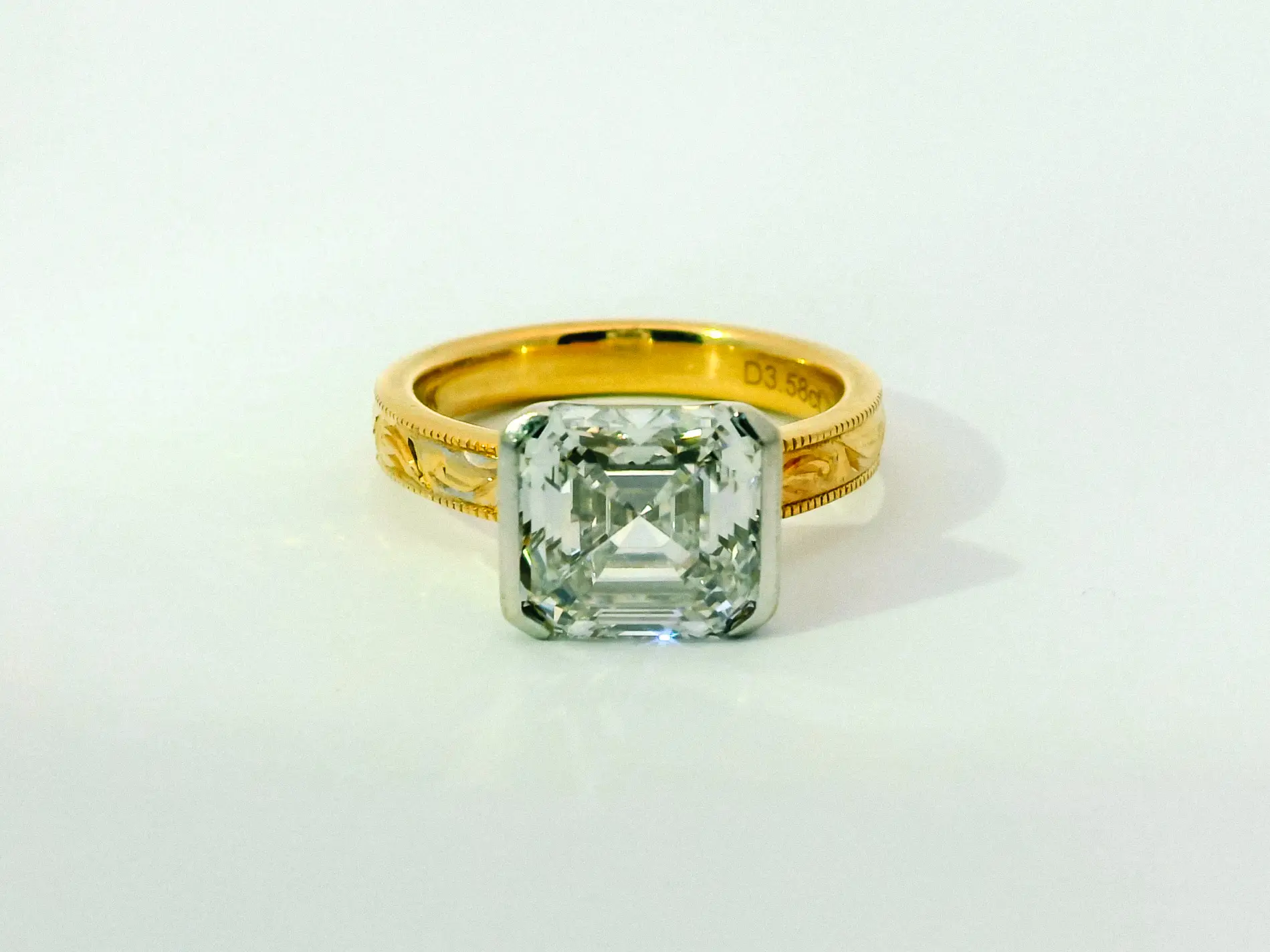
#
Gabrielle’s Ideals for Asscher Cut Diamonds #
(Table: 60–68% (66–67%), Depth: 65–70% (67–69%), Pavilion Depth: 44–54% (49–52%), Pavilion Angle: 40.4–41.5° (40.2°–41.25°), Crown Angle: 33–35° (33.7°–35.8°), Crown Height: 12–15%, Girdle: 2.5–4.5%)
The Asscher cut diamond is a stepped square cut known for its deep, mesmerizing facets that create a “hall of mirrors” effect. With its perfect symmetry, high crown, and signature cropped corners, the Asscher cut offers a refined elegance that blends vintage charm with modern sophistication.
The Asscher cut was created in 1902 by Joseph Asscher, a renowned diamond cutter in the Netherlands. It quickly became a hallmark of Art Deco design, celebrated for its clean lines, geometric precision, and architectural elegance. The original Asscher cut had 58 facets, but in the early 2000s, the design was modified into the “Royal Asscher Cut,” featuring 74 facets for enhanced brilliance.
Today, the Asscher cut remains a favorite for those who appreciate understated luxury and timeless appeal.
Asscher diamonds face up smaller per carat than brilliant-cut diamonds due to their deep cut and high crown. However, their step-cut facets create a striking depth and visual intrigue, making them one of the most uniquely elegant shapes.

#
1. What Is an Asscher Cut Diamond? #
The Asscher cut diamond features a step-cut facet arrangement, meaning its light performance relies on broad, open flashes of white light rather than the glittering brilliance of a round or oval. The result is an elegant, dramatic play of light that resembles mirrored reflections inside the stone.
The ideal length-to-width ratio for an Asscher cut is 1.00–1.05, ensuring a perfectly square or nearly square appearance.
Why Choose an Asscher Cut Diamond?
- Timeless Art Deco Appeal:
A signature of the 1920s and Art Deco movement, the Asscher cut has a distinctly vintage and architectural feel.
- Sophisticated Light Performance:
Unlike brilliant cuts, Asscher diamonds offer broad, open flashes of light, creating a unique, hall-of-mirrors effect.
- Incredible Clarity & Depth:
The large step-cut facets highlight purity and clarity, making this an excellent choice for high-clarity diamonds.
- Strong, Durable Structure:
With cropped corners and a balanced depth-to-table ratio, Asscher diamonds are more durable than pointed shapes like marquises or pears.
Potential Downsides of an Asscher Cut Diamond
- Smaller Face-Up Appearance:
Due to their depth, Asscher diamonds appear smaller per carat than round or elongated shapes.
- Clarity is Critical:
The large open facets make inclusions more visible, so clarity should be a priority.
- Less Fire & Brilliance:
Step-cut diamonds focus on broad, clear flashes of light, rather than the constant sparkle seen in brilliant cuts.
- Limited Setting Versatility:
Asscher cuts look best in vintage, solitaire, or Art Deco-inspired settings—if you want a modern, super-sparkly look, a brilliant cut may be a better choice.
#
2. The 4Cs for an Asscher Cut Diamond #
Cut – The Foundation of a Beautiful Asscher Diamond
- Table Percentage (IGI Ideals: 60–68% | Gabrielle’s Ideals: 66–67%)
A well-proportioned table allows light to be properly dispersed across the stone, avoiding a glassy or overly dark appearance.
- Depth Percentage (IGI Ideals: 65–70% | Gabrielle’s Ideals: 67–69%)
Depth is essential for balancing light reflection and structural integrity—too shallow, and the stone lacks depth; too deep, and it appears small for its carat weight.
- Pavilion Depth (IGI Ideals: 44–54% | Gabrielle’s Ideals: 49–52%)
Pavilion depth controls how light moves through the diamond, affecting brightness and contrast.
- Pavilion Angle (IGI Ideals: 40.4–41.5° | Gabrielle’s Ideals: 40.2°–41.25°)
Ensures the hall-of-mirrors effect is crisp and evenly distributed.
- Crown Angle (IGI Ideals: 33–35° | Gabrielle’s Ideals: 33.7°–35.8°)
A higher crown improves contrast and enhances the bold flashes of light seen in step-cut diamonds.
- Crown Height (12–15%) & Girdle (2.5–4.5%)
These elements ensure the diamond maintains strong light return and structural durability.
Pro Tip: Well-cut Asscher diamonds should have crisp, symmetrical step facets and deep, mirror-like reflections—not a glassy or overly dark center.
Color – Choosing the Right Shade
Asscher diamonds tend to show color more than brilliant cuts, so color selection is important.
- D–F (Colorless): Best for an icy-white, high-end look, especially in platinum or white gold.
- G–H (Near Colorless): A great balance between value and whiteness.
- I–J: Some warmth may be visible, but pairs well with yellow or rose gold.
Pro Tip: If setting in platinum or white gold, stay in the D–H range for a bright, crisp look. If setting in yellow or rose gold, an I–J color can still appear beautifully white.
Clarity – Choosing Eye-Clean Stones
The open step-cut facets of an Asscher cut make inclusions more visible than in brilliant cuts.
- VVS1–VVS2: Virtually flawless—ideal for those who want perfection.
- VS1–VS2: The best value—high clarity without overpaying.
- SI1–SI2: Some SI1 stones can be eye-clean, but avoid inclusions in the center of the stone.
Pro Tip: Stick to VS1 or better to ensure a clean, bright appearance with no visible inclusions.
Carat – Maximizing Size Without Compromising Cut
Asscher diamonds face up smaller per carat than round or elongated cuts.
Pro Tip: If maximizing face-up size is important, consider a slightly larger carat weight or a more elongated step cut like an emerald diamond.
3. Additional Considerations #
Symmetry & Polish
- Symmetry: A well-cut (Excellent) Asscher should have perfectly aligned steps and crisp, defined facets.
- Polish: Affects facet sharpness and overall light return—look for Excellent or Very Good polish.
Fluorescence
- None or Faint fluorescence is best—strong fluorescence can create a hazy appearance.
Certification
- Always buy IGI- or GIA-certified diamonds to ensure accurate grading.
Setting Considerations
- Best Settings:
- Vintage-inspired settings enhance the Art Deco appeal.
- Bezel settings add protection while maintaining a clean, modern look.
- Halo settings amplify brilliance and visual size.
#
Final Thoughts #
A well-cut Asscher diamond is one of the most elegant and timeless step cuts available. With broad, mirror-like flashes of light, deep clarity, and a unique vintage aesthetic, it’s a perfect choice for those who appreciate sophisticated, architectural beauty.
By following Gabrielle’s Ideals, you can confidently select an Asscher cut diamond that is well-balanced, high-performing, and full of depth and dimension.
Happy diamond hunting—may your Asscher diamond reflect elegance, precision, and history!


